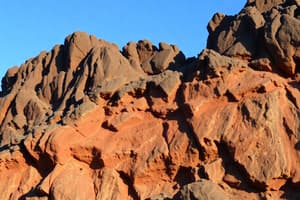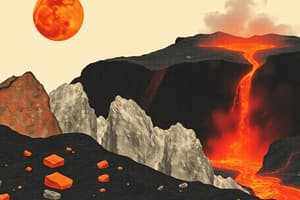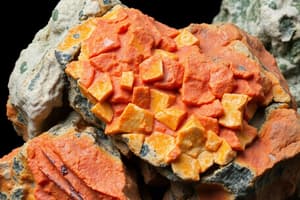Podcast
Questions and Answers
Which of the following is NOT a characteristic of minerals?
Which of the following is NOT a characteristic of minerals?
- Inorganic
- Naturally occurring
- Can be man-made (correct)
- Solid
What is the difference between a mineral and a rock?
What is the difference between a mineral and a rock?
- Minerals are solid, while rocks can be solid or liquid.
- Minerals are formed through natural processes, while rocks are man-made.
- Minerals are inorganic, while rocks are organic.
- Rocks are made of minerals, while minerals are the building blocks of rocks. (correct)
What is an outcrop or exposure?
What is an outcrop or exposure?
- The process of rocks changing form over time
- An exposed rock surface (correct)
- A layer of rock that is buried deep underground
- A type of rock found in specific locations
Why are rock-forming minerals essential for identifying and classifying rocks?
Why are rock-forming minerals essential for identifying and classifying rocks?
What is the meaning of the term 'crystalline solid' when applied to minerals?
What is the meaning of the term 'crystalline solid' when applied to minerals?
Which of the following is an example of an outcrop?
Which of the following is an example of an outcrop?
What is the significance of the rock cycle in understanding Earth's geology?
What is the significance of the rock cycle in understanding Earth's geology?
What type of rock is composed of minerals that have been cemented together?
What type of rock is composed of minerals that have been cemented together?
What is the main component of animal shells and skeletons?
What is the main component of animal shells and skeletons?
Which type of igneous rock is formed by rapid cooling?
Which type of igneous rock is formed by rapid cooling?
What are the two stages of cooling in a porphyritic rock?
What are the two stages of cooling in a porphyritic rock?
Which of the following factors contribute to the formation of sedimentary rocks?
Which of the following factors contribute to the formation of sedimentary rocks?
What is the smallest sediment particle size mentioned in the content?
What is the smallest sediment particle size mentioned in the content?
Which type of igneous rock is characterized by large, visible crystals?
Which type of igneous rock is characterized by large, visible crystals?
Which of the following minerals is not a silicate mineral?
Which of the following minerals is not a silicate mineral?
Which of the following is not a process involved in the formation of sedimentary rocks?
Which of the following is not a process involved in the formation of sedimentary rocks?
What is the main component of the Earth's crust?
What is the main component of the Earth's crust?
Which of the following is a characteristic of igneous rocks formed by rapid cooling?
Which of the following is a characteristic of igneous rocks formed by rapid cooling?
Flashcards
Mineral
Mineral
A naturally occurring, inorganic, crystalline solid with a specific chemical composition.
Rock
Rock
A naturally occurring aggregate of one or more minerals, forming a coherent solid.
Rock Cycle
Rock Cycle
A series of processes that describe the transformation of rocks through various forms (igneous, sedimentary, metamorphic).
Igneous Rock
Igneous Rock
Signup and view all the flashcards
Sedimentary Rock
Sedimentary Rock
Signup and view all the flashcards
Metamorphic Rock
Metamorphic Rock
Signup and view all the flashcards
Outcrop
Outcrop
Signup and view all the flashcards
Crystalline Structure
Crystalline Structure
Signup and view all the flashcards
SiO4 Tetrahedra
SiO4 Tetrahedra
Signup and view all the flashcards
Feldspar
Feldspar
Signup and view all the flashcards
Quartz
Quartz
Signup and view all the flashcards
Aphanitic Texture
Aphanitic Texture
Signup and view all the flashcards
Phaneritic Texture
Phaneritic Texture
Signup and view all the flashcards
Lithification
Lithification
Signup and view all the flashcards
Sediment Transport
Sediment Transport
Signup and view all the flashcards
Sediment Particle Sizes
Sediment Particle Sizes
Signup and view all the flashcards
Study Notes
Lecture 3: The Rock Cycle
- The rock cycle is a continuous process where rocks are transformed from one type to another through various geological processes.
- Rocks are formed from minerals, which are naturally occurring, inorganic, crystalline solids with a specific chemical composition.
- Rocks are aggregates of one or more minerals.
- Rocks are coherent, in contrast to a handful of sand.
Mineral Properties
- Minerals are naturally occurring, inorganic, crystalline solids with a specific chemical composition.
- Minerals have a repeating crystalline structure.
Rock Types
- Igneous rocks: Formed from the cooling and solidification of magma or lava.
- Extrusive igneous rocks (volcanic): Cool quickly on the Earth's surface, forming fine-grained textures.
- Examples: Rhyolite, Andesite, Basalt.
- Intrusive igneous rocks (plutonic): Cool slowly beneath the Earth's surface, forming coarse-grained textures.
- Examples: Granite, Diorite, Gabbro.
- Classification is based on the minerals present and the texture.
- Extrusive igneous rocks (volcanic): Cool quickly on the Earth's surface, forming fine-grained textures.
- Sedimentary rocks: Formed from the accumulation and cementation of sediments. Sediments are weathered and eroded from pre-existing rocks or precipitates. They undergo lithification.
- Types: Detrital (fragments from pre-existing rocks) and chemical/biochemical (minerals extracted from solutions or produced by organisms).
- Examples: Sandstone, conglomerate, limestone.
- Types: Detrital (fragments from pre-existing rocks) and chemical/biochemical (minerals extracted from solutions or produced by organisms).
- Metamorphic rocks: Formed from the transformation of existing rocks by heat, pressure, or chemical reactions. They do not melt completely.
- Types: Foliated (due to pressure creating layers) and nonfoliated (doesn't have layers).
- Examples: Slate, schist, gneiss, marble, quartzite.
- Classification based on the composition and texture (foliated/nonfoliated).
- Types: Foliated (due to pressure creating layers) and nonfoliated (doesn't have layers).
Sedimentary Rock Formation: Lithification
- Sediments accumulate
- Sediments are compacted by weight of overlying material.
- Sediments are cemented by minerals.
- Sediment particle sizes: Gravel, sand, silt, and clay
Rock Cycle Processes
- Weathering and erosion: Breaks down rocks into smaller pieces.
- Transportation: Moves sediments.
- Deposition: Accumulates sediments.
- Lithification: Compacts and cements sediments to form sedimentary rocks.
- Metamorphism: Alters rocks by heat, pressure, or chemical reactions.
- Melting: Creates magma, which can cool and solidify to form igneous rocks.
- Uplift and exposure: Brings rocks to the surface.
Igneous Rock Classification
- Aphanitic: Rapid cooling, small crystals.
- Phaneritic: Slow cooling, large crystals.
Metamorphic Rock Formation
- Igneous or sedimentary rocks are changed by heat and pressure
- Types of changes:
- Compositional (new minerals form).
- Textural (minerals align) - Foliated textures.
- Depending on the degree of metamorphism, or the original rock type, different types of metamorphic rocks result.
Foliated vs. Non-foliated Textures
- Foliated: layers in the rock result from pressure.
- Examples: Slate, schist, gneiss
- Non-foliated: Rocks that cooled/were formed without layers
- Examples: Marble, quartzite
Studying That Suits You
Use AI to generate personalized quizzes and flashcards to suit your learning preferences.




